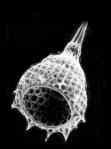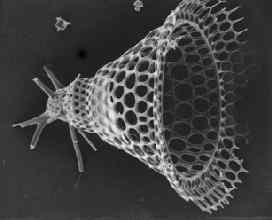


 |
Introduction & Morphology |
 |
Geological Application |
 |
Distribution in Space & Time |
 |
Glossary |
 |
Links |
 |
Home |
| | |
GEOLOGICAL APPLICATION - pg 2.
 During the last few decades global warming and the greenhouse effect have become a growing concern, therefore, studies have been dedicated to the analysis of climatic changes in various geographic areas. Since climatic patterns have been changing from its natural cycles over the past few centuries paleoecology and paleoclimatology attempt to understan
d and interpret what the effects of today's climate will have on such microfossils and the environments in which they live. Polycystine radiolarians are among the few tools available for investigating these changes in the oceanic realm.
During the last few decades global warming and the greenhouse effect have become a growing concern, therefore, studies have been dedicated to the analysis of climatic changes in various geographic areas. Since climatic patterns have been changing from its natural cycles over the past few centuries paleoecology and paleoclimatology attempt to understan
d and interpret what the effects of today's climate will have on such microfossils and the environments in which they live. Polycystine radiolarians are among the few tools available for investigating these changes in the oceanic realm.
The techniques in question are based on comparisons of the radiolarian assemblages in the water column and/or in the topmost sedimentary layer, with those retrieved from sediments buried deeper under the sea floor. Each assemblage is characterized by a particular combination of species. Because radiolarians are sensitive to environmental conditions, different species and species proportions in the assemblages are indicative of different living conditions, in particular water temperature and productivity. Thus, qualitative and quantitative differences between a recent assemblage and one produced, for example, 50 years ago, can offer valuable information on changes in the prevailing environmental conditions that cause the observed fidderences in the radiolarian assemblages.
